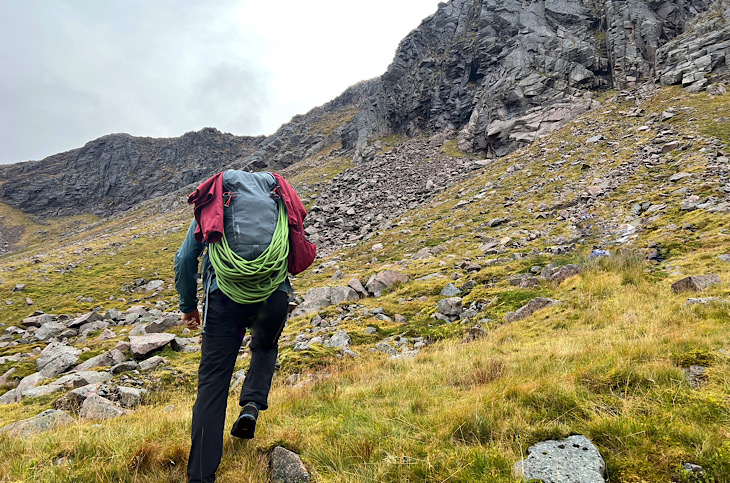Osprey Mutant 52 Review Climbing Backpack
Osprey Mutant 52
Weight: 3 lbs. 3.2 ounces (small/medium)
Capacity: 22, 38, 52 litres.
What we like: The Osprey’s carrying comfort and build quality are packaged into a full-fledged alpine pack.
What we don’t like: Too heavy, large and bulky to use on technical rock or ice.
Osprey is perhaps best known for its impressive line of backpacks, but they’ve taken that experience and adapted it for the mountains with the release of the climbing-focused Mutant. We took the 52-liter version on an expedition to the Alaskan mountain range, using it as a hiking backpack and as our main bag for a four-day trip through the mountains. While not our first choice for touring, the Mutant 52 has all the alpine features we typically look for and is quickly proving itself to be a suitable vehicle for long approaches and technical high-altitude travel. Below we detail our experience with Mutant. To see how they compare, read our article on the best backpacks for climbing.
Osprey Mutant 52 Review
Performance

Carrying Comfort
Although the Osprey Mutant 52 is designed as a lightweight, minimalist climbing pack, it’s a true leader in comfort. First, the backpack has a durable internal suspension consisting of a frame and a foam lining. Additionally, hip belt supports and weight lifters, which are often missing from mountaineering backpacks, allow you to effectively customize the Mutant to best fit your body. Although the shoulder straps and waist belt have rather thin padding, the backpack is able to withstand even heavy loads well. I wore the Mutant for 10 days straight and experienced no hot spots, chafing, or pressure points. Even when it exceeded the 50-pound payload limit (with a raft, oars, ice axe, snowshoes, overnight gear, and a few days’ worth of food), the Mutant rode close to my body and never felt cumbersome.
Compared to other mountaineering backpacks, the comfort of the Mutant is even more impressive. Although their padding is minimal by backpacking standards, many alpine packs have less support and design to keep the weight down. For example, the Hyperlite Mountain Gear 3400 Ice Pack and Arc’teryx Alpha FL use thin pieces of foam instead of heavier, more supportive frame sheets (and the Hyperlite also has removable aluminum seatstays). But while you can get by with less weight when carrying lighter loads, we found that good load distribution and good support are essential for a pack of this size, and the Osprey handles both tasks with aplomb.
The mutant is also highly customizable: you can reduce its size to make it bigger. By removing the frame panel, foam padding and strap, the backpack can be adjusted to ride higher on the back and perhaps travel as an extension of the body (i.e. with little load). They also have a slightly tapered shape (wider at the top and narrower at the bottom), which is perhaps a better way to support weight when climbing. However, the big Mutant 52L is bulky, and for technical rock and ice climbing we prefer to step down to the 38L version or another option like Arc’s Alpha FL 40 or Alpha FL 30’teryx.
Weight
The small/medium Mutant I tested weighed 3 pounds, 3.2 ounces and had a carrying capacity of 50 liters. This puts it in a tough spot among mountaineering packs of its size, but it’s important to note that the Mutant is more comfortable and well-rounded than most of its competitors. In comparison, the Black Diamond Speed 50 is slightly lighter, weighing 2 pounds 11 ounces, and has a similar feature set. Arc’teryx’s lightweight Alpha FL 40 weighs just 1 pound, 9 ounces, but without a frame or top cap, a braided hip belt, and fewer external mounting points, you’re missing out on a lot in terms of comfort and versatility ( not to mention the overall power). Likewise, the Hyperlite Ice Pack 3400 (55L) is surprisingly light at 1 pound, 13.6 ounces, but it costs $370 and has a very limited feature set. Lastly, the weight of the Osprey is very reasonable considering its comfort and overall design.
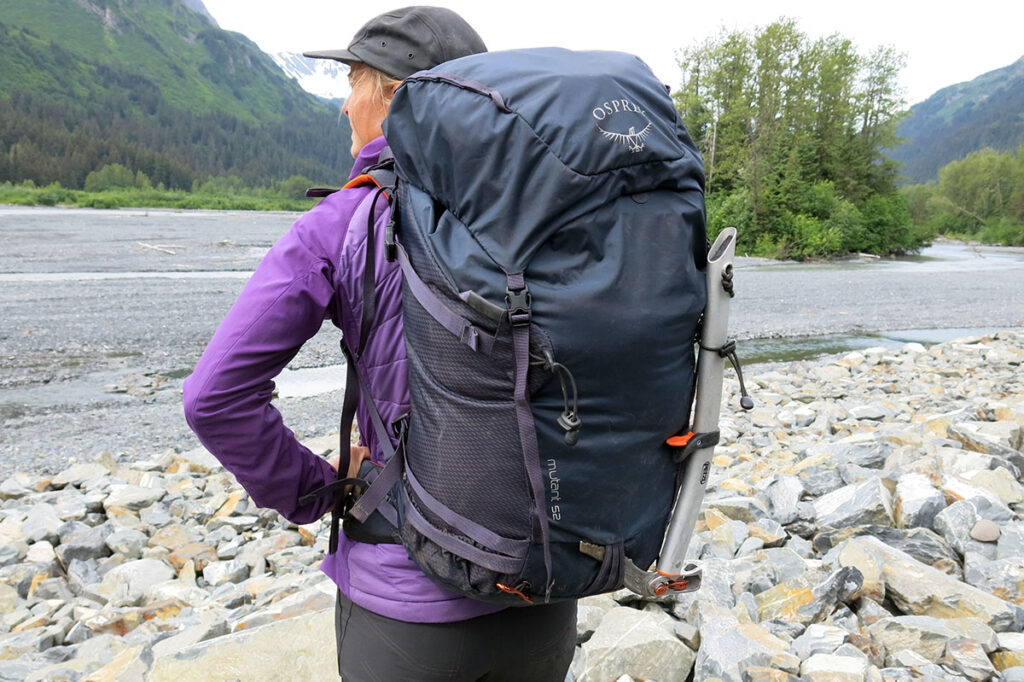
Like many weight-conscious mountaineering backpacks, the Mutant features removable elements including the hip strap, top lid, frame, foam liner, and helmet holder. Removing these items reduces the pack’s weight by approximately 1.5 pounds and effectively reduces its bulk. The helmet holder and top cover have been largely retained (using the integrated FlapJacket to cover the main compartment), but the suspension components have not been removed (we recommend using the backpack only without the frame and the padding). and a lap belt if carrying a very light load). For some packs, this simplified ability can result in a decent technical climbing pack, but unfortunately that’s not the case with the Mutant. As I mentioned, I’m unlikely to take the Mutant 52 on a trip given its large size (the Mutant 38L, which is also detachable, is a much better option).
organized
With tons of organizational options inside and out, the Osprey Mutant 52 is one of the most feature-rich mountaineering backpacks on the market. First, you have a spacious main compartment (only accessible by closing the top drawstring) with an internal pocket for your hydration pack. The Mutant also has a removable top flap, which is often missing from mountaineering backpacks, which I used as a handy bag at base camp and on pre- and post-trip trips. More importantly, the Mutant offers a range of outdoor alpine gear organization options, which proved extremely useful on our glacier-to-river trip: I was able to carry an ice axe, snowshoes, a four-piece paddle, and A helmet. And tie it all out of my bag. While this may seem like a rubbish tip (which isn’t entirely inaccurate), the Mutant has dedicated straps for each item and handles loading very well.

Given the alpine focus, it is important to clearly highlight the versatility of the Mutant crampons for outdoor activities. The backpack includes a carrying strap that serves as an internal compression strap to adjust your gear, two external compression straps (one of which is a quick release), pockets on each side, and a helmet carrying net that attaches to the hood or the front of the helmet. package. group. . In addition, three reinforced loops can be combined for vertical loading or used as additional external storage, daisy chain on both sides of the front panel, two strong side loops can be used to attach A-frame skis, both sides of the cotton strap. The holder is suitable for an ice carabiner, particularly useful for ice excursions. Finally, the two ice ax attachment points share a central pocket, but be careful: these “ToolLocks” only fit tools with a hole in the head (like the Petzl Sum’Tec). The only omission I noticed is a patch for attaching the straps, but you can easily improvise if necessary.
Overall, I was incredibly impressed with the Mutant’s feature set while exploring the Alaska Range. Simply put, it has a lot more external adjustments than you’re used to seeing in a climbing group, meaning it can be effectively overloaded on the approach and then greatly simplified at the base of the camp (as climbers are known to do ). In this sense, I prefer Mutant to simple packs like Alpha FL and Ice Pack.
Ventilation
Unlike many Osprey bags which feature suspended mesh to allow air to circulate behind your back, the Mutant has a very simple design and has no built-in ventilation. However, the translucent Snowshed back panel (prevents snow buildup) is very effective at wicking moisture. Compared to my competitors, I prefer the feel and breathability of this Dyneema fabric and textured nylon packs like the Hyperlite Ice Pack, Arc’teryx Alpha FL 40, and AR 35. And perhaps most significantly: all the time spent on very difficult terrain. , I didn’t experience any overheating while using Mutant.
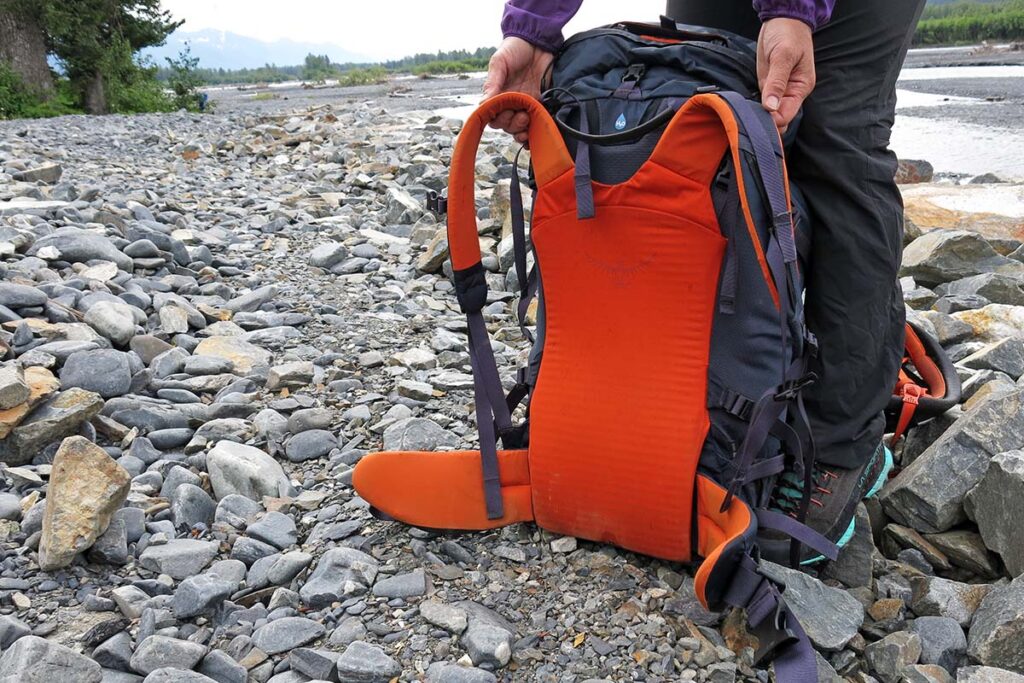
Build quality and durability
Like most Osprey packs we’ve tested, the Mutant is made with durable materials, strong stitching, and thoughtful design. However, despite its light weight, the bag’s 210 x 420 denier (D) nylon frame is thinner than most mountaineering gear.
Fit and size
The unisex Osprey Mutant 52 backpack comes in two sizes, small/medium and medium/large, and weighs roughly three ounces. Unlike many backpacks, the mountaineering-oriented Mutant has very little adjustability and doesn’t allow you to change the torso length or hip belt position. However, I was able to use the lap belt attachments, weight lifters, and sternum strap adjuster to effectively customize the fit. As a result, I had no complaints – the converter fit perfectly and comfortably to the body.
Other Capacities of the Osprey Mutant
We tested the 52-liter Mutant bag (Osprey’s dedicated mountaineering bag designed for multi-day missions), but the pack is also available in smaller 38- and 22-liter versions. It’s a little lighter, however, weighing 2 pounds, 11.2 ounces, supports up to 40 pounds, and doesn’t have a removable hip belt. We believe this capability represents a more versatile option for both approach and climbing. Finally, the Mutant 22L ($100) is the best climber of the bunch: compact, aerodynamic, and ideal for hauling technical rocks and ice. Instead of a hood, the 22L has a single top zipper and a smaller waist belt, but weighs just 1 pound, 4.8 ounces.
What we like
With its blade-shaped frame and typical Osprey snug fit, the Mutant handles heavy loads very well for a mountaineering backpack.
The backpack offers numerous outdoor carrying options without looking unsightly or cumbersome to load.
Often absent from mountaineering backpacks, the top flap makes an excellent organizational bag for base camp.
What we don’t do
The 52-liter Mutant is fully removable, but we’d never carry such a bulky bag on technical snow or rocks. The smaller Mutant 38 is more versatile and ideal for both overnight charging and on-the-go use.
Ice ax accessories are only compatible with tools that have a slot or slot in the head.
While we had no issues with setup, the suspension system offers very little adjustability.
Competition
“Climbing backpack” is a generic term that includes high-end mountaineering backpacks, trail backpacks, medium-capacity approach and climbing backpacks, and heavy-duty backpacks that can carry loads for several days in mountainous terrain. The 52L Osprey Mutant belongs to the latter group, joined by Black Diamond’s Speed 50. The two packages have similar features, cost about the same, and have remarkably similar feature sets. However, the Speed manages to include a padded back panel, numerous organization options, and a removable shoulder strap, case, and frame at a price 9 ounces less than the Mutant. The snow attachment is also a little more versatile in terms of speed, and we appreciated the additional protection provided by the tow strip (which the Mutant doesn’t have). Overall, we think the Mutant wins in most key categories, including comfort, build quality, and value.
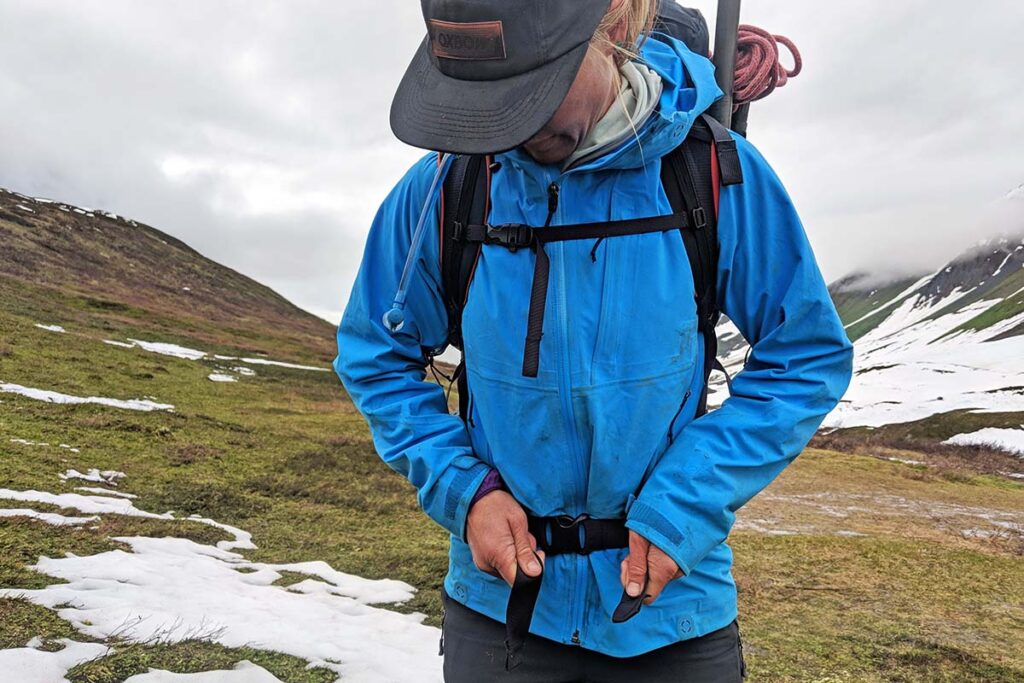
In the same category as the Mutant and the BD Speed 50 is the Alpha AR (“all-terrain vehicle”) 55 from Arc’teryx. The Alpha AR has multiple external mounting points, belt loops, and a removable case and frame. You also get a larger capacity of 55 liters with slightly less weight (2 pounds, 14 ounces) than the Osprey, and at a reasonable price of $200 (by Arc’teryx standards, of course). However, the Osprey is better padded and offers greater carrying comfort, making it the preferred choice for long trips when you need extra support to comfortably carry a large load. For long and very light daytime missions, the lighter and more aerodynamic Alpha AR is a valid alternative.
Continuing the Arc’teryx line, the Alpha FL (“fast and light”) 40 is one of the most popular mountaineering backpacks on the market, and for good reason. The 1-pound, 9-ounce pack sits close to the back and high up, effectively moving as an extension of the climber’s body. We also like the fold-over closure, which lets you adjust the collar to use as a dual-approach/on-the-go bag, or extend and fill it up to your nostrils for multi-day runs. However, this versatility comes at a significant sacrifice in comfort: Thanks to the woven waistband and thin inner lining (no straps or frame), the Alpha FL pales in comparison to the Mutant. The Arc’teryx package also has far fewer features, which saves weight but comes at the expense of comfort and organization. Ultimately, the Mutant, which cost $40 less, benefited from richer features and the ability to carry heavier loads.
We especially like Patagonia’s highly customizable and versatile design: for longer hikes, use a rope harness and side compression straps for protect the team; Once you’re on the road, remove the hip belt cover, frame and padding (you can also remove the compression straps) and adjust the pack to perfection. In use, we found the Ascensionist lifts better than the Mutant, and it’s also lighter (2 pounds, 13.2 ounces) and more durable thanks to its 420-denier ripstop nylon shell. However, the Osprey wins in terms of overall comfort over extended multi-day periods, which is why we ranked it higher in our mountaineering backpack rankings.
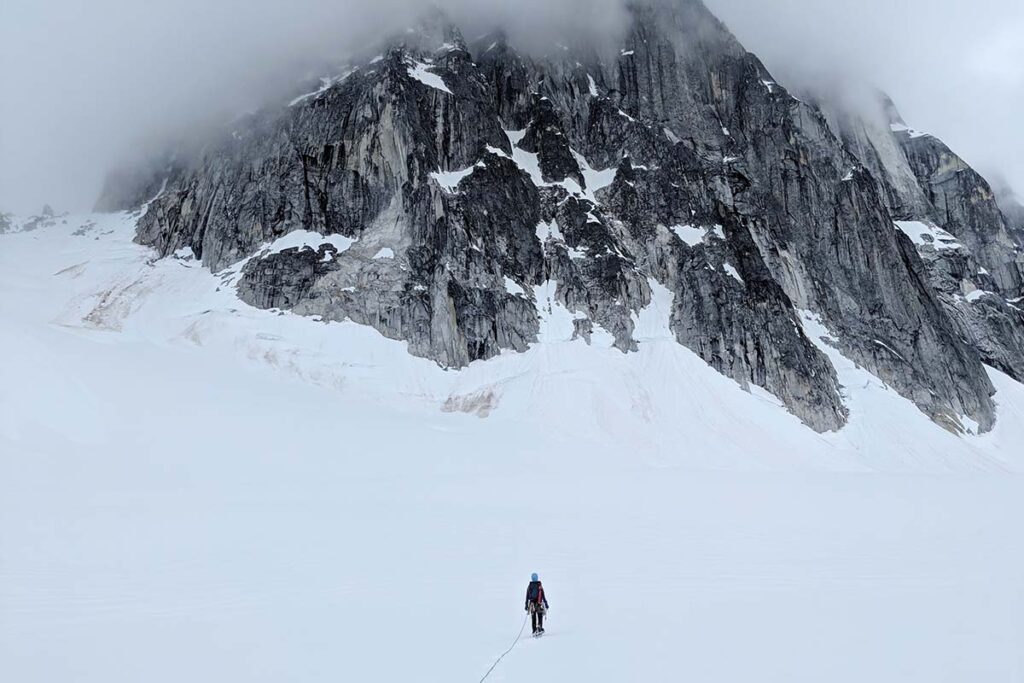
The final contender to consider is the 3400 Ice Pack from Hyperlite Mountain Gear. How do these two plans differ? In particular, the Dyneema construction of the snow shell guarantees superior durability and waterproofness, two important factors for a mountaineering backpack. However, the Ice Pack isn’t as comfortable as the Mutant due to the lack of a frame (it uses a foam pad and ¼-inch thick supports), and you can also expect a significant reduction in ventilation. Additionally, the Hyperlite, with its roll-top closure (no flap), no helmet or peg storage pockets, and no carrying loops, is less versatile. For weight-conscious climbers, the 1-pound, 13.6-ounce Hyperlite can cost $370. But if you’re more interested in carrying comfort and overall performance, opt for the heavier, more feature-packed Mutant.

